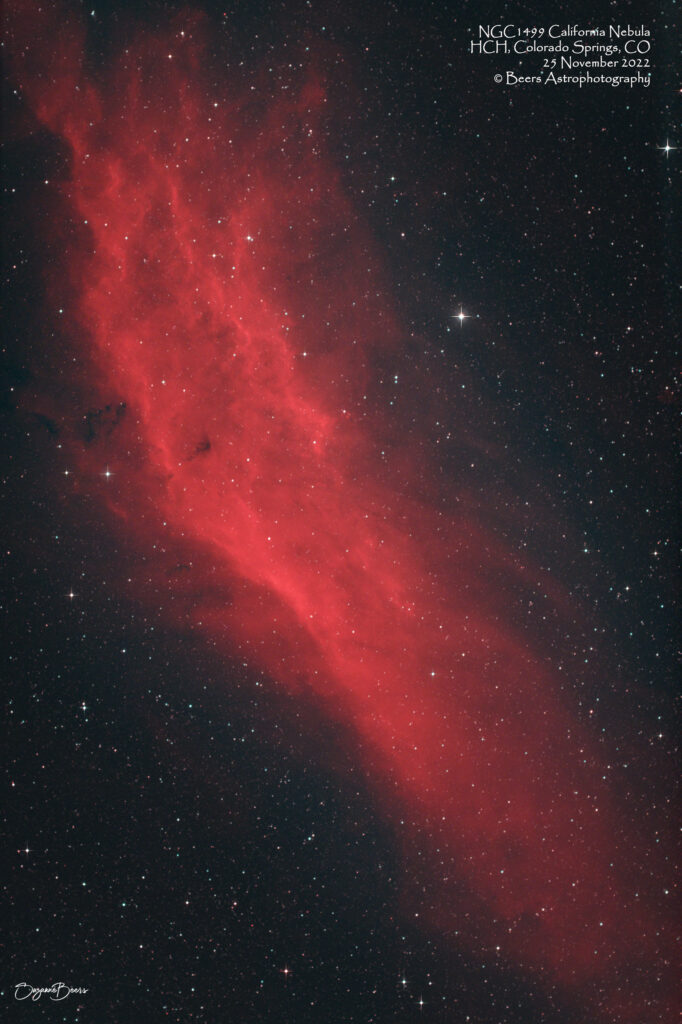
Fun facts
NGC1499 California Nebula is an emission nebula located in the constellation Perseus. Its name comes from its resemblance to the outline of the US State of California in long exposure photographs. It is almost 2.5° long on the sky and, because of its very low surface brightness, it is extremely difficult to observe visually. It can be observed with a Hα filter (isolates the Hα line at 656 nm) or Hβ filter (isolates the Hβ line at 486 nm) in a rich-field telescope under dark skies. It lies at a distance of about 1,000 light years from Earth. Its fluorescence is due to excitation of the Hβ line in the nebula by the nearby prodigiously energetic O7 star, Xi Persei (also known as Menkib).
The California Nebula was discovered by E. E. Barnard in 1884.
By coincidence, the California Nebula transits in the zenith in central California as the latitude matches the declination of the object. NASA selected the California Nebula as its Astronomy Picture of the Day on October 22, 2022, based on a submission from an amateur astronomer taken from a ground-based telescope.
Other Catalog Designations: NGC1499, SH2-220
Subtype: Emission Nebula
Distance from Earth: 1000 light years
Visual Magnitude: 6.0
Constellation: Perseus
{ from: https://en.wikipedia.org/wiki/California_Nebula }
Capture Notes
This was the first successful capture with the DSO-CTRL-2 laptop after struggling with file format settings, heat (cold) management, and polar alignment on the previous night. Those struggles provided a lesson in setting the file format, setting the laptop power management so I can close the cover and wrap more tightly in the towels. Finally, the difference in processing in APP for .fits files – first version turned out black and white, second version had a horrible vignette and green hue (although the nebula itself had a lot of detail). This is the recaptured data on the following night, with the file format corrected and the heat management solved. After attempting to stack the files captured in .fits and learning several lessons: 1) you have to select debayer CFA in step 0 (otherwise you get a mono image as the output) ; and 2) the calibration frames also have to be in .fits format (otherwise you get the most bizarre looking vignetted image).
Equipment
Polar alignment: QHYCCD camera (controlled by Polemaster)
Imaging stream: Askar FRA600, Canon EOS Ra with Optolong LeXtreme light pollution filter
Mount: Rainbow Astro RC-135E (controlled by iHubo)
Autoguider: Orion 60mm Multi-Use Guide Scope, Orion StarShoot AutoGuider Pro Mono Astrophotography Camera (controlled by PHD2)
All equipment controlled by HP Probook running Sequence Generator Pro v3.2.0.660.
Capture & processing notes
Sequence plans: ISO3200, 57x5min, Total = 4:45hrs. Captured 24Nov2022, 1930MST – 25Nov2022, 0057MST. Last 4 images (good ending at 0036MST) had to be deleted, as would not register in APP
Capture: 24 November 2022
Shooting location: Colorado Springs, Colorado
Processing: Stacked in APP using 99% of subframes, processed in LR/PS.
